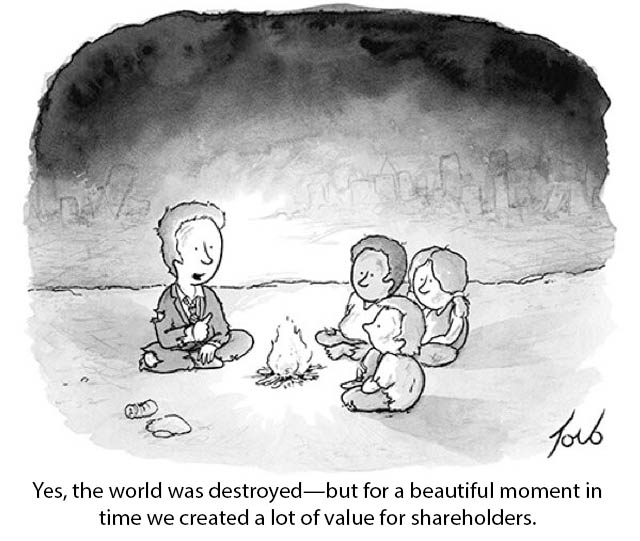
FRIDAY, DEC 25, 2020: NOTE TO FILE

Our Fossil Fuel Future
We are the fossil-fueled empire
Eric Lee, A-SOCIATED PRESS
TOPICS: FOR A TIME, FROM THE WIRES, FULL SPEED AHEAD, WITHIN LIMITS FOR A TIME
Abstract: The details of our trajectory are uncertain. Our growth to date can be plotted. Beyond the now are increasing uncertainties as to details such as when the peak for all fossil fuels will occur, whether the climax and descent will be gradual—extended over a century or so or comparatively rapid, and will it be bell-curved or shark-finned? Initial down turns may reverse and descent may level off for a time or growth could resume (for a time). That the trajectory will climax and descend, however, is as foreseeable as that of an arrow shot up, up, up into the air. Of course the future remains uncertain. Aliens from Ometron could arrive and save us from ourselves. Or Klaatu could solve Earth's human infestation problem. At its high point, an eagle could grab the arrow and fly off with it. But that almost every time an arrow is shot into the air, it falls I know not exactly where, is the better, as in more likely, story.
COOS BAY (A-P) —Just sticking to the fact that fossil fuels are finite, that we are using them as fast as we can grow our economies, and that at some point in the next million years (or much sooner), extractable and burnable fossil fuel use will climax and descend, greatly simplifies projecting possible futures. Ignored in the graphics below is the possible collapse of the economy merely due to failure of the financial system (e.g. 1929), or rapid degrowth because I become world potentate and decree all fossil fuel use ends in five years because we should seek out the condition now that will come anyway and because maybe we shouldn't make the planet uninhabitable to life as we know it (or at least the ones who don't know how to make and power ACs). Or maybe maximizing our use of fossil fuels is interfered with by a plague that kills 89% of humans the first year. The future is uncertain, but that climax and descent are decidedly likely, as likely as a shot arrow at some point coming down to Earth, perhaps after being dropped by an eagle, is worth noting.
If you believe in growth, that growth, even unto overshoot, is good (because we will soon decouple from nature), then I have some land in Florida 17 cm above high tide for sale at a price that is too good to be true. There is full grid-tie to the mansion with AC units in every room. The pool heater has been replaced with a cooler. Enjoy it now! I've already had six offers, but make me an offer I can't refuse and it is yours.
So, given that any image we have of our future, with or without fossil fuels in it, is as imagined, then also take as a given that some futures are more likely than others. Science is the endeavor to tell likely stories. For our fossil-fueled future, let's let those who endeavor to listen to Nature (who has all the answers) and who envision possible futures based on biophysical reality, tell us a story. Understand, however, that in the graphics below, as most potential causes of failure are ignored, the projections below are on the optimistic side of probable futures.
In 2014 we were offered for consideration a study, per Google Scholar cited to date 359 times, called 'Projection of world fossil fuels by country' that actually only singles out four countries for consideration, but the world is worth considering, so let's start with the projected consumption of our planet's current larder of fossil fuels, what is left of them.
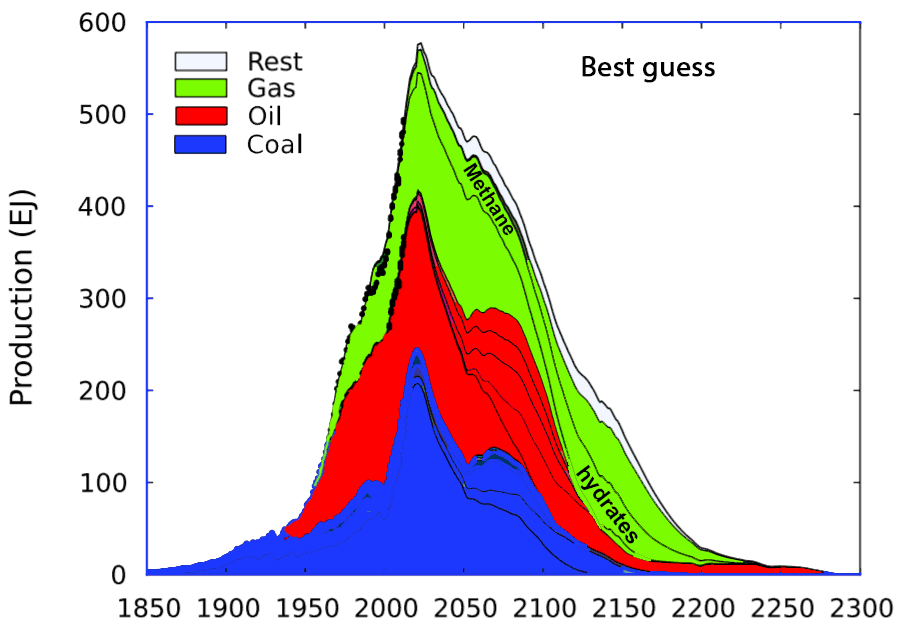
The 'rest' is added to allow for 'possible' new and emerging fossil fuel sources as (or if) they become technically and economically accessible, ones we don't yet know about or how to exploit. Maybe we'll mine ocean methane hydrates to burn instead of letting global warming release them into the atmosphere. Who can't get all enthusiastic about that? But if we find new fossil fuel sources (techno-optimists assert they will be found so they had to be factored in), they will still be limited. The projections are based on Ultimately Recoverable Resources (URR) metrics, and are maximally optimistic. The above is the 'best guess' projection, but if high range guesses are right, then climax may be greatly extended.
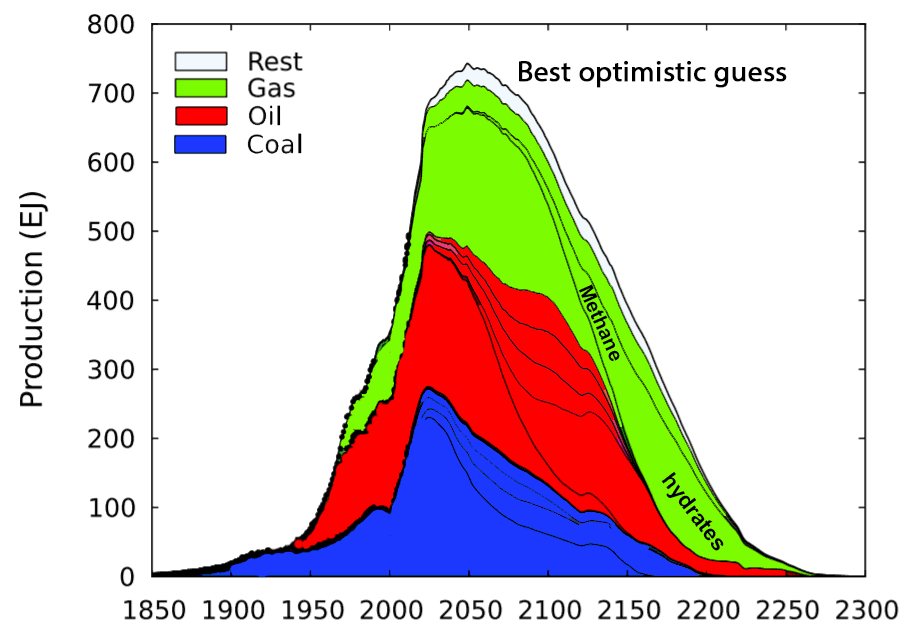
The authors, experts who are informing the fossil fuel industry and policy makers, do not mention declining EROI as a constraint. If the economy demands more, it will be provided even if the energy return on energy invested is less than one. If it is 'out there' and we throw enough money at it, it will be extracted (within the limits of it being out there and physically recoverable). Still, that energy experts now recognize limits to fossil fuel extraction and use is progress of a sort.
That the reason we use fossil fuels is because, for a time, the EROI has been high enough to rapidly growth the world economy, and that when the ever declining EROI drops us off the exergy cliff, then our ability to keep on extracting fossil fuels to make solar panels, wind turbines, flood vast areas of arable land by building hydroelectric dams, or turn oil/electric into food will end far sooner than imagined by techo-optimist cornucopians, The authors guess global oil production might peak in 2025. It seems to have happened in 2018.
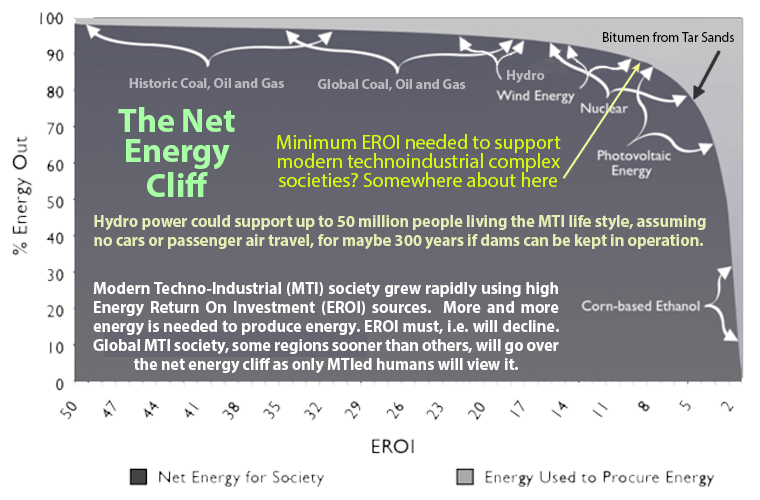
The authors, and just about all the experts money can buy, agree that ending fossil fuel use will be a good thing, because we'll substitute cleaner and greener energy sources. Even those working for Big Oil/Gas/Coal and soon to come Big Methane Hydrate agree (provided we don't waste what could be sold and burned to benefit humankind). There will always be poor people who need a growing economy. Of course, because God loves us, he will find (or show clever apes) alternative energy sources to provide energy too cheap to meter.
Actually, emergy yield ratios do matter and as high EROI/EYR fossil fuels go, so goes our technoindustrial pretend civilization (over the net energy cliff).
Oh, but it is Xmas, and the above is so doomerish. Why must it take until 2119 for humans to get right with Mother? No, we must not give into despair. We can embrace descent and 'seek out the condition now that will come anyway'. Or if not now, let's give ourselves a generous five years to transition. Call it The 5-Year Plan to Save the World. Develop the plan now and in a few years, when humans have a teachable moment, they'll vote Ecolate Party, and we can implement it.
First, we end all fossil fuel use in five years (except for grain/dry food production needed to be stored to prevent a Malthusian die-off by starvation). We ban all over-powered vehicles (OPV, e.g. electric cars, passenger planes, motor boats/ships) within five years: 20% of streets closed to OPV the first year and regional airports closed, 25% of remaining the second, 33% the third, 50% of remaining the fourth, and 100% the fifth year to achieve zero OVP (IC vehicle and electric car/truck) use by end of fifth year.
There are no alternative machines or energy sources to empower transport (aka life) as we know it. Food will no longer travel 1,500 miles on average to get to the end of your fork. You will walk, or perhaps those in need of speed or the elderly, will have use of a bicycle or tricycle. You will actually be part of slowing the pace of planetary destruction whether you believe you are or not.
 Second, we live local on environmental resources/productivity while managing our demands on them, because that's what works, bitches, but only after a rapid birth-off to prevent a die-off. Easy if you know how.
Second, we live local on environmental resources/productivity while managing our demands on them, because that's what works, bitches, but only after a rapid birth-off to prevent a die-off. Easy if you know how.
- Vote with your feet to join the ecolate (currently perhaps some fraction of a percent of humanity) in a viable area able to support humans (e.g. probably not Slab City in the Mojave desert, Phonenix Arizona, LA, or any urbanized area near you).
- Everyone agrees to ask a friendly neighborhood population biologist how many humans, at the specified level of per capita consumption of environmental resources, the area (a watershed management unit or WMU) can support.
- The EO ones (named after E.O. Wilson) stockpile a 50 year supply of anoxicly stored food, perhaps enough to support ten times the carrying capacity of the area, to take in refugees later on (for humanitarian reasons, but also to select for functional humans with an interest in protecting resources, i.e. drug addicts who live by stealing are unlikely to be accepted when humanity's teachable moment comes).
- All agree to forfeit their 'right' to reproduce at will (or will go back to an urban-scape near them, for a time).
- During their first five years (their test time), no intensional refugee will reproduce as the maladapted will leave (e.g. takers, users who can only take).
- The number of babies born each year needed to maintain a viable population that the WMU can sustainably support at the level of prosperity (consumption) agreed to, is determinable.
- Anyone who can follow simple math knows what the number is, and that one way or another the viable birth rate is determined (i.e. humans don't get a vote apart from subjective/adaptive issues of 'just enough' vs 'too much').
- Initially, few women who want to 'be with child' can be, but in 50 years humanity can be back to what works at about 2.1 children per woman (or less and go extinct) and without a Malthusian die-off.
- Avoiding passage into and perhaps through a Malthusian scarcity induced death-spiral needs to be avoided as it selects for dysfunctional behaviors and memes.
- If only those humans with the most ammo in their bug-out bunker survive, it is still game over for viable civilization as little information and much misinformation is selected for.
- Refugees from technoindustrial society will need to recover functional behaviors (reverse our behavioral sink), perhaps by living in band-sized groups (20-50) as our ancestors did for hundreds of thousands of years, and with such self-help community support (e.g. from grandmothers) as possible.
- The rest of humanity, who kept on keeping on in their BAU ways, will mostly be dead or busy eating each other (for a time).
- If, during their die-off, they are prevented from conquering the Birth-off people, the EO ones, then humans could transition to a memetic species that sort of understands the planet and can learn to live with it properly, unlike the MO ones, the metastatic ones of the Anthropocene.
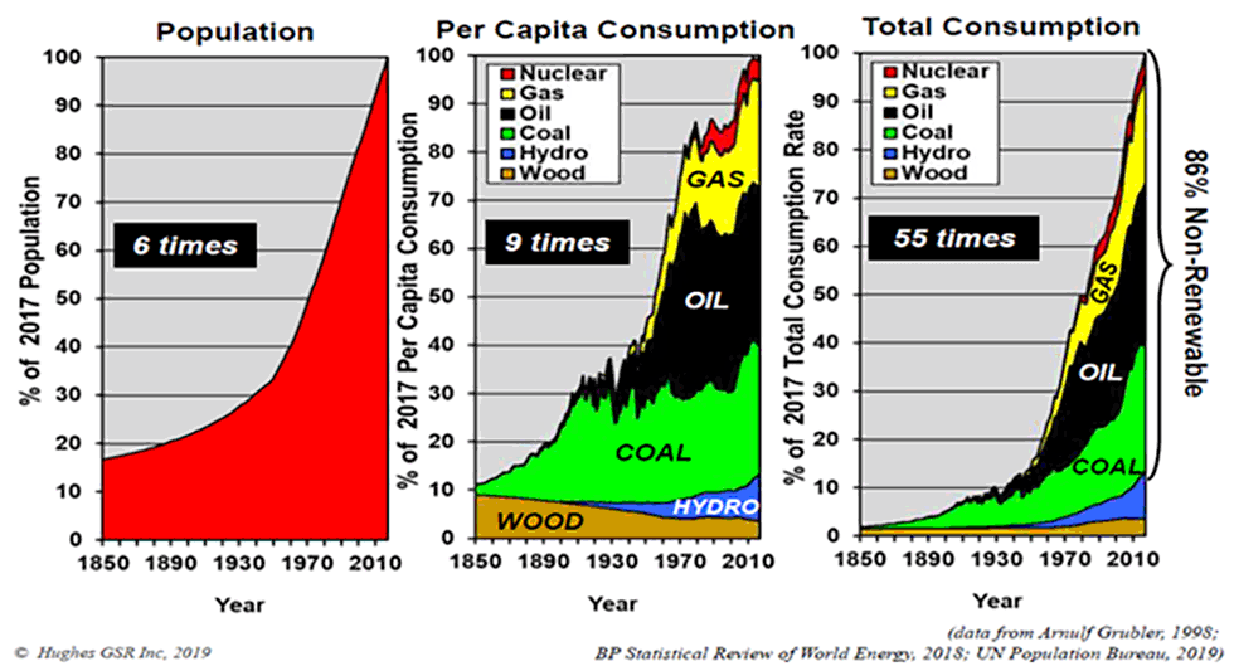
As for my eudaimonic, Pollyannaish vision of a prosperous way down to a viable future for humanity and the biosphere, of prosperous people (maybe 35 million of them) living on an abundant Earth, kindly accept it as a gift (okay, not from me, Nature told me to tell you... maybe we should think about living in a viable ecolate civilization... or not).
And for a vision of the 'or not':
